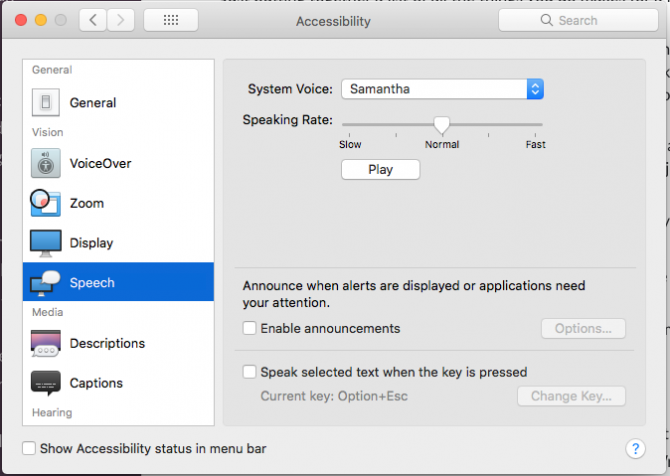Whether you're creating audio clips for your own weekly technology podcast, or looking to write your own Siri spoof videos, you too can make Siri say anything you want, using any Mac computer and built-in utilities. We'll show you how.
Download The Siri Voice
First things first, let's get the real Siri voice, though technically her name is Samantha. Voice recognition and text-to-speech settings, both of which are built into the core OSX, can all be found in System Preferences -> Accessibility -> Voice.
If you're on an old version of Mac OS, you'll find this in System Preferences -> Voice instead.
Click Play to preview that voice.
For the most recent versions of Mac OS, this should default to Samantha, which is the classic Siri voice as we all know her. On older versions, you'll need to add the Samantha voice to your system. To do this, click on the System Voice selection box, and choose Customize. Scroll down to English (United States) - Female, and tick Samantha. If you click OK, it'll prompt you to download the required files which are about 300-400MB per voice. Daniel is the official Siri voice of the UK.
Wait for the download to complete, then choose Samantha from the drop down.
Get Her To Say What You Want
The Terminal / Command Line is the easiest way to do this. Find it under Applications -> Utilities -> Terminal. Type in the following command, replacing the text in quotes with whatever you want Siri to say!
say "Master, my name is Siri. I am here to serve your every desire"
Save The Output
To use the synthesised speech in our project, we need to output it to a file. To do this, add the -o switch the command, followed by a file name.
say -o "filenameGoesHere" "Master, my name is Siri"
Note that when you run this, it will not play the voice - only save to the file. It's an .aiff file - and by default, it's going to save in the root of your users' home directory. To save to the desktop, just issue this command first:
cd Desktop
which will change the current directory to the desktop.
A few more tips - if you have a large amount of text you want to read, save it to the same directory as a plain text file, and instead of specifying the text to say, add the -f switch and the filename of your text file, like this:
say -o "outputFile" -f "inputFile"
To change the voice being used without having to go into System Preferences every time, use the -v switch:
say -v "Daniel" "I am Daniel, the voice of iPhone 4S in Britain"
So, how awesome is this? Very, is the response you're looking for I believe. If you enjoyed this, please consider sharing the article using the buttons below. If you have any more tips or would like to show off your Siri project in the comments, then go ahead, I'm looking forward to checking them out. Don't forget to check out all our other Siri-related articles too.
And remember, Siri also works on your iPhone. However, starting with iOS 13, you don't need to enable Siri to control your iPhone!


